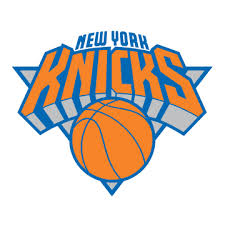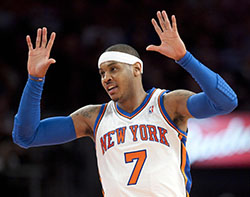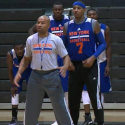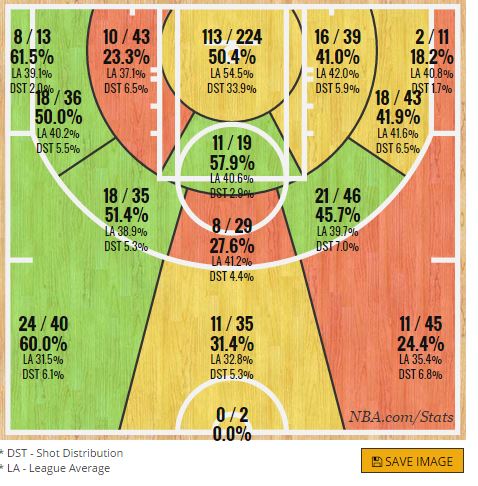 The New York Knicks have lost five straight games and are now 2-6 after wins over Cleveland and Charlotte in their first three contests. So what are the Knicks doing so poorly over the league’s first two-plus weeks?
The New York Knicks have lost five straight games and are now 2-6 after wins over Cleveland and Charlotte in their first three contests. So what are the Knicks doing so poorly over the league’s first two-plus weeks?
The offense is disastrously slow and inefficient
The Knicks’ 88.7 Pace, or approximate possessions per game, is the worst in the league. New York has consistently gone late into the shot clock as they learn the Triangle offense, looking for the perfect pass or cut to get an open look. NBA.com’s team tracker shows that the Knicks are making 349 passes per game, third most in the NBA. Their hot-potato offense hasn’t worked yet, given that their 91.1 points scored per game is dead last in the league.
Knicks head coach Derek Fisher said on Monday that sometimes players are being unselfish to a fault.
“We have a lot of guys that just aren’t being aggressive and playing with their instincts,” Fisher said, “and they’re being a little bit passive right now trying to fit into the team chemistry.”
To make matters worse, the Knicks aren’t coming close to maximizing their efficiency on those few possessions they have. Their points scored per shot is a paltry 1.1, tied with Detroit for worst in the league. Their shot selection isn’t great either.
They’re taking low-percentage shots
NBA.com defines an Elbow Touch as “touches that originate within the 5 foot radius nearing the edge of the lane and free throw line, inside the 3 point line.”
The Knicks lead the league with 37.3 elbow touches per game, NBA.com says, by far the highest mark in the league, 7.7 touches more per game than the second place Grizzlies.
New York also happens to rank last in Close Touches, which are players touching the ball close to the basket. Here’s how the Knicks stand in attempts and percentages offensively:
| Knicks Shot Selection (league rank) | Attempts | FG % |
| Less than 5 Feet | 23.4 (28) | 56.7 (24) |
| 5-9 Feet | 6.5 (29) | 25 (30) |
| 10-14 Feet | 8.1 (5) | 30.8 (27) |
| 15-19 Feet | 19.4 (2) | 48.4 (3) |
| 20-24 Feet | 13.6 (19) | 34.9 (26) |
| 25-29 Feet | 10.6 (9) | 42.4 (1) |
The Knicks take far too few shots close to the basket (stats do not include Tuesday night’s games) and when they do attempt them, they don’t make enough of them. If the Knicks are 27th in the league in shooting percentage between 10 and 14 feet, perhaps they should try to go towards the rim.
New York has excelled at those mid-range, 15-to-19 foot shots, but perhaps they should step back a little and attempt more 3-point shots. Their 18.3 attempted 3’s per game ranks 23rd in the league.
To show you what all this means, we’ll bring in our good friend the shot chart to illustrate the Knicks’ shot selection so far this season.
The Knicks take just 33.9 percent of their shots in the restricted area and barely hit over 50 percent of them, more than four percentage points below the league average.
New York takes 46 percent of its shots inside the 3-point line but outside the restricted area, a really high amount. Houston, which leads the NBA in points per shot with 1.35, takes just 14.6 percent of their shots in this range.
Leaguewide, the Knicks rank sixth in 3-point field goal percentage, at 38.4 percent, but attempt just 18.3 of them, 23rd in the league. Just 3.7 percent of the Knicks’ shots are corner threes, a ridiculous number considering that shot is regarded as one of the best to take. Milwaukee takes 0.8 more threes than the Knicks per game, yet 7.6 percent of their shots are corner threes.
(MORE: Scotto: Autopsy of Phil Jackson’s State of the Knicks Address)
They lack offensive aggression
 The Knicks haven’t gotten enough close touches, as we saw earlier, and that’s affected their trips to the free-throw line. They take just 15.6 free throws per game, last in the league by nearly three attempts per game.
The Knicks haven’t gotten enough close touches, as we saw earlier, and that’s affected their trips to the free-throw line. They take just 15.6 free throws per game, last in the league by nearly three attempts per game.
“As guys get more comfortable with where those opportunities are, to just be aggressive and attack,” Fisher said, they’ll get to the line more.
But until that happens, the Knicks aren’t shooting free throws, getting touches close to the basket or attempting many 3-pointers. They’re settling for low-percentage twos farther away from the basket than they should be shooting.
And to make matters worse, some Knicks believe, though others denied this, that their offensive woes are impacting their defensive play.
“That’s been an epidemic in the NBA for a long time,” Fisher said. “When things aren’t going great offensively, defense is hard to play for guys.”
Knicks center Jason Smith agreed. “I think we’re allowing our offense to affect our defense,” he told SheridanHoops. “I think it’s just a mindset of no matter what happens on the offensive end, if we make a shot or if we don’t make a shot, we always have to get back and play defense.”
They’re unable to defend without fouling
 The team takes 15.6 foul shots per game while allowing their opponent to shoot 27.6 of them, which is the sixth-worst mark in the league.
The team takes 15.6 foul shots per game while allowing their opponent to shoot 27.6 of them, which is the sixth-worst mark in the league.
Fisher said defending without fouling is a big focal point for the team.
“Being a little more alert in some situations, understanding personnel and being able to be prepared based on what teams are doing offensively,” Fisher said, would help as well. He said that defending without fouling is just as mental as it is physical, involving digesting film study and practicing to prepare yourself for the actual on-court work.
Avoiding fouls and the dead-ball, half-court dominated possessions and the set defenses that come with them, Fisher said, would allow the team to get out in transition more and get some better offensive flow. That would improve the team’s pace and give them more possessions to figure out their schemes and shot selection.
Defending is a problem, especially from 3
The Knicks’ defensive rating, points allowed per 100 possessions, is 110.9, 26th in the NBA. They allow 1.3 points per shot, good for 27th in the league.
Those two numbers are poor primarily because of their inability to defend the 3-point shot. They allow teams to shoot 41.8 percent from three, the worst number in the league by 1.3 percentage points. To be more specific for a second, opponents hit 51.7 percent of their left corner treys against the Knicks (fifth worst in the league) and connect on 40.3 percent of their above-the-break threes (second worst).
Their defensive problems could stem from learning a new defensive system that was so different from last season’s, which was heavily dependent on defensive switches. Point Guard Shane Larkin told SheridanHoops that the team’s adjustment to the new scheme is taking longer than they had originally anticipated, but change needs to happen fairly soon for the Knicks to avoid the same 10-21 start they had a season ago.
Conclusion
The Knicks are still working on developing their players so they can fit into their systems on both sides of the ball to achieve what Fisher termed sustained success. But while this learning process is going on, the Knicks have been hard to watch in almost every aspect.
